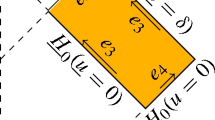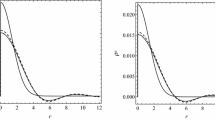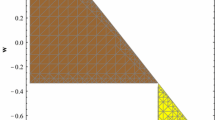Abstract
We study the stability of occurrence of black holes and naked singularities that arise as the final states of a complete gravitational collapse of type I matter field in a spherically symmetric N-dimensional spacetime, with the equation of state p = kρ, 0 ≤ k ≤ 1. We prove that for a regular initial data comprising pressure (or density) profiles at an initial surface t = ti, from which the collapse evolves, there exists a large class of velocity functions and classes of solutions of Einstein equations such that the spacetime evolution goes to a final state which is either a black hole or a naked singularity. We use suitable function spaces for regular initial data leading the collapse to a black hole or a naked singularity and show that these data form an open subset of the set of all regular initial data. In this sense, both outcomes of collapse are stable. These results are discussed and analyzed in the light of the cosmic censorship hypothesis in black hole physics.
Similar content being viewed by others
References
R. C. Tolman, Proc. Natl. Acad. Sci. 20, 169 (1934).
J. R. Oppenheimer and H. Snyder, Phys. Rev. 56, 455 (1939).
P. C. Vaidya, Proc. of the Indian Acad. Sci. A 33, 264 (1951).
A. Papapetrou, “Formation of a Singularity and causality,” in “A Random Walk in Relativity and Cosmology” (Wiley Eastern, New Delhi, 1985).
Y. Kuroda, Prog. Theor. Phys. 72, 63 (1984).
D. M. Eardley and L. Smarr, Phys. Rev. D 19, 2239 (1979).
D. Christoudolou, Comm. Math. Phys. 93, 171 (1984).
A. Ori and T. Piran, Phys. Rev. D 42, 1068 (1990).
R. Goswami and P. S. Joshi, Phys. Rev. D 69, 104002 (2004).
S. G. Ghosh and A. Beesham, Phys. Rev. D 64, 124005 (2001).
A. Banerjee, U. Debnath, and S. Chakraborty, Int. J. Mod. Phys. D 12, 1255 (2003), gr-qc/0211099.
K.D. Patil, S.H. Ghate, and R. V. Saraykar, Ind. Jour. of Pure and App. Maths. 33, 379 (2002).
P. S. Joshi and I. H. Dwivedi, Class. Quantum Grav. 16, 41 (1999).
P. S. Joshi, Pramana-J. Phys. 55, 529 (2000), grqc/0006101.
P. S. Joshi and R. Goswami, Physical Review D 69, 064027 (2004).
R. Goswami and P. S. Joshi, Class. Quantum Grav 21, 3645 (2004).
A. Mahajan, R. Goswami, and P. S. Joshi, Phys. Rev. D 72, 024006 (2005).
L. Randall and R. Sundram, Phys. Rev. Lett. 83, 3370 (1999).
L. Randall and R. Sundram, Phys. Rev. Lett. 83, 4690 (1999).
T. Kaluza, Sitz Preuss. Akad.Wiss.D 33, 966 (1921).
O. Klein, Z. Phys. 895 (1926).
S. B. Sarwe and R. V. Saraykar, Grav. & Cosmol. 10 4(40), 329 (2004).
S. G. Ghosh, S. B. Sarwe, and R. V. Saraykar, Phys. Rev. D 66, 084006 (2002).
N. Dadhich, S. G. Ghosh, and D. W. Deshkar, Int. J. Mod. Phys. A 20, 1495 (2005).
R. Penrose, Riv. Nuovo Cimento 1, 252 (1969); in General Relativity, an Einstein Centenary Volume, edited by S. W. Hawking and W. Israel (Cambridge University Press, Cambridge, England, 1979).
R. Abraham and J. Marsden, Foundations of Mechanics, 2nd edition (The Benjamin/Cummings Publishing Company, Menlo park, CA, 1978).
S. B. Sarwe and R. V. Saraykar, Pramana, J. Phys. 65(1), 17 (2005).
F. Verhulst, Non-linear Differential Equations and Dynamical Systems (Berlin: Springer, 1989).
S. W. Hawking and G. F. R. Ellis, The Large Scale Structure of Space-time (Cambridge University Press, Cambridge, 1973).
R. Goswami and P. S. Joshi, Phys. Rev. D 76, 084026 (2007).
R. V. Saraykar and S. H. Ghate, Class. Quantum Grav. 16, 281 (1999).
P. S. Joshi, Daniele Malafarina, and R. V. Saraykar, Int. J. Mod. Phys. D 21(8), 12500036 (2012).
Author information
Authors and Affiliations
Corresponding author
Rights and permissions
About this article
Cite this article
Sarwe, S., Saraykar, R.V. Stability analysis in N-dimensional gravitational collapse with an equation of state. Gravit. Cosmol. 20, 282–289 (2014). https://doi.org/10.1134/S0202289314040124
Received:
Published:
Issue Date:
DOI: https://doi.org/10.1134/S0202289314040124




